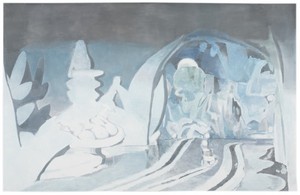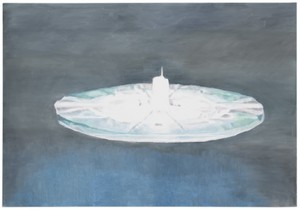This is an archive of the ArtCat Zine, 2007-2009. Please visit our new project, IDIOM.
Luc Tuymans at David Zwirner
Forever the Management of Magic
Luc Tuymans
David Zwirner - 525 W 19 St, New York NY
14 February - 22 March 2008
W. G. Sebald begins one of his essays with a quote from Michel Foucault:
We must therefore listen attentively to every whisper of the world, trying to detect the images that have never made their way into poetry, the phantasms that have never reached a waking state. No doubt this is an impossible task in two senses; first because it would force us to reconstitute the dust of those actual sufferings and foolish words that nothing preserves in time; second, and above all, because those sufferings and words exist only in the act of separation.
Sebald, a German writer who came of age in the trauma of post-war Germany, produced works that meditated upon memory, both collective and personal. His seminal work, Austerlitz, follows its principle character, adopted as an infant, as he travels Europe, examining its Architectural monuments and hoping to uncover the elusive mystery of his parentage. Through a blend of fact, fiction, philosophical insight, and photographic records, Sebald weaves a melancholy tale that ultimately traces the horror of the holocaust through records and the very architecture marking the land like monuments of the dead.
Luc Tuymans, a painter of moribund and starkly hued images, also believes that the objects of history are never free of the haunting traces of memory. His paintings, like Sebald’s perambulatory tale, raise the holographic insistence of a reality that surrounds the comfortable knowable images of our world with the ghosts that once imbued them with life and even death. To appropriate a phrase of Balzac’s, they are "a perfect image of the past, a symbol of something great now destroyed, a poem."
That is not to say that Tuymans focus is never in the present. If anything, his work is arguably opportunist. His last show at David Zwirner in 2005 was occupied by an examination of contemporary American power. The seminal images of the show, one pursed lip portrait of Secretary of State Condoleezza Rice and another of a demolished building, both literally and figuratively addressed the stresses of American power post 9/11.
Tuymans has always been ambivalent about the political content of his pictures. Though his past works have dealt with the colonial occupation of the Congo by his native Belgium, he has tried to avoid moralizing his position, as he stated in Modern Painters: “I admit power is something that fascinates me […] but that’s not moralizing, rather it’s an attempt to underscore meanings. It’s never an accusatory, pointed finger.”
Nevertheless, the 2005 show at Zwirner seemed to complicate the assertion that he was simply documenting the dark places of history — here was Tuymans making a point about the negative effects of American Imperialism. Forever, The Management of Magic, now up at David Zwirner, does nothing to dispel that claim.
Forever comes with a loaded press release, detailing the content of each of the abstracted images in the exhibition, which are all drawn from ephemera surrounding the Walt Disney Corporation. Many of the paintings and drawings are centered on the plans for the EPCOT (Experimental Prototype Community of Tomorrow) project, a centrally planned community designed by Disney (and sinisterly resembling Jeremy Bentham’s Panopticon), that was never built.
An integral metaphor in the exhibition, EPCOT symbolizes not just an unrealized project, but also the failure of a utopian promise by a corporation that ultimately prizes profit over its feel-good philosophy. Disney, of course, is emblematic of American values, and Tuyman’s view of its various projects is obviously intended to indirectly question the aspirations and failures of American ideology.However, the pictures themselves hardly suggest this — without the benefit of the press release we are confronted with a series of shimmering abstract paintings whose images suggest an elegiac beauty. Turtle, a painting that is based upon a float in one of Disney’s defunct attractions, could suggest the nighttime lights of a far off city, or even the vague, rain-washed outline of a couple kissing in a psychedelic downpour. Another painting, Epcot, based on the aforementioned EPCOT plans, looks like a glowing roulette wheel, a flying saucer, or the remains of a candle.
Tuymans is often accused of painting everything in the same way, but here he has settled into a dreamy brushiness. The objects of his investigations flicker like dying candlelight in an autumnal dusk, and what is left of their forms float across the canvas like will-o-wisps. Stylistically, at least, he has produced the eulogy that the press release practically shrieks.
Style only goes as far as setting the mood, however. Tuymans is unable to integrate contextualization into the internal processes of his work. Without the attributions of the press release, the paintings would be a pleasant, if melancholy series of ambiguous abstractions and landscapes. Tuymans' method of historical painting commits him to charting a dangerous territory between didacticism and obscurantism. His images are only one half of “those sufferings and words [that] exist only in the act of separation.”
ZINE
HOME
TIPS / COMMENTS
CATEGORIES
CONTRIBUTORS
- Greg Afinogenov
- B. Blagojevic
- Adda Birnir
- Susannah Edelbaum
- Julie Fishkin
- Paddy Johnson
- Jessica Loudis
- Christopher Reiger
- Andrew Robinson
- Peter J. Russo
- Blythe Sheldon
- S.C.Squibb
- Hrag Vartanian


